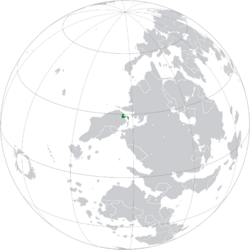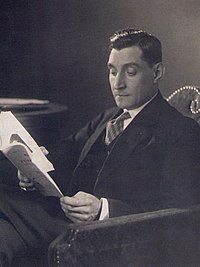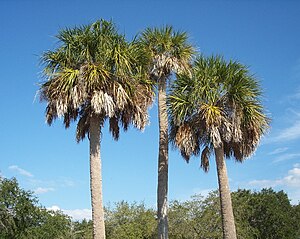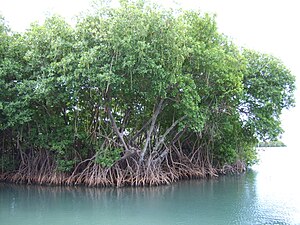Aurora
This article is incomplete because it is pending further input from participants, or it is a work-in-progress by one author. Please comment on this article's talk page to share your input, comments and questions. Note: To contribute to this article, you may need to seek help from the author(s) of this page. |
Republic of Aurora República de Aurora (Stillian) | |
|---|---|
| Motto: "Quod perierat, invenietur" "What was lost will be found" | |
| Anthem: "Placeholder" "Placeholder" | |
 Map of Aurora within Cashari Island of Alharu | |
| Capital | Tavares |
| Largest | Catalina |
| Official languages | Anglish Stillian |
| Recognised national languages | Eirran !Seminole |
| Demonym(s) | Auroran |
| Government | Unitary presidential republic |
• President of the Republic | Shea Sherburn |
| Legislature | Congress of Aurora |
| Senate | |
| Chamber of Representatives | |
| Independence from New Eire | |
| Area | |
• | 42,346 km2 (16,350 sq mi) (28) |
| Population | |
• 2023 estimate | 14,650,803 (82) |
• Density | 345.97/km2 (896.1/sq mi) |
| GDP (nominal) | 2023 estimate |
• Total | AD$ 731.886 billion (17) |
• Per capita | AD$ 49,956 (5) |
| Currency | Auroran sol (AOS) |
| Time zone | UTC-7 (AST) |
| Date format | mm-dd-yyyy (CE) |
| Driving side | right |
| Calling code | +123 |
| ISO 3166 code | AO |
| Internet TLD | .ao |
Aurora, officially the Republic of Aurora, is a country in western Alharu. It is located on the eastern coast of Cashari Island, one of the largest islands in the wurld. Aurora is comprised of two distinct regions: the continental mainland, situated on Cashari Island; and the insular Arcadian Islands of the Hei Sea. The country straddles the western shore of the Hei Sea, while sharing a southern border with South Aurora, and further, its Rosarios Island territory shares a maritime border with Florentia and Ocraly. Aurora is home to 14,650,803 people, within an area of just 42,346 km2 (16,350 sq. mi). The capital of Aurora is Tavares, while its largest city is Catalina. Other cities of interest include Ashbourne and Santa Petra. The country experiences a rich blend of cultural heritage, reflective of a complex colonial history and the continual relevance of immigration in Auroran society. Anglish and Stillian are both sanctioned by the Auroran government as official languages, while Eirran and !Seminole continue to be recognized by the government for their respective historical roles in weaving the diverse fabric of Aurora today.
Paleo-Cashari peoples are estimated to have first arrived to what is today Aurora on Cashari Island between 20,000 and 13,000 years ago. At the time of Europan arrival, a multitude of culturally distinct peoples inhabited the region, including the [Timucua], [Tocobaga], [Ais], [Calusa], [Apalachee], and later [Muskogee/Seminole] societies. Europans would first encounter Auroran natives in 1599, with the arrival of Juan Luis Cárdenas de Tavares’ southward expedition as part of The Gran Viatge, soon followed by large-scale colonization in 1623 when Teobaldo Franco Cabeza del Toro abandoned Deiargon’s colony at Providencia and led his followers to the lands described by Tavares’ expeditions. Similarly, Eirran colonizers would establish settlements along the northern coast of the Cashari Island in 1650, growing over the next century through an influx of Eirrans, Albans, and East Cerisers into thriving settler colonies. The Eirrans would eventually conquer present Aurora from a failing Iberic Empire.
Aurora would gain independence in 1810 in the Orange Blossom Revolution. Continually through the 19th century, Aurora would face a century-long struggle with the Florentian Empire for sovereignty and power in the Hei Sea region. By the end of the century, Aurora had asserted itself as the dominant power in the region, as Florentia fell into civil war. Aurora would continue to face internal issues and corruption, however, culminating in a coup d'état by General Arturo Gabriel Vizcaíno. This period, from 1941 to 1947, is the darkest in Auroran history, marked by violence, racial discrimination, misinformation, and the erosion of democratic principles. Vizcaíno's regime would finally be ousted with the Liberation of Aurora, supported by [intervening power], in June of 1947.
Etymology
The name Aurora comes from Fragran for "dawn" or "light." In Aroman mythology, Aurora is the name of the goddess of dawn.
History



Government and politics
Legislative branch
Executive branch
Judicial branch
Political parties
Foreign affairs
Military
Administrative divisions
Geography
Climate
Fauna
Aurora boasts a diverse variety of wildlife, including over 700 terrestrial species, 200 freshwater fish, 1,000 marine fish, and a vast array of insects and other invertebrates.[1] Aurora's unique fauna is reflective of a temperate-to-tropical climatic gradient, while its diverse habitats support a high degree of speciation.
Mammals
The Aurora panther, sandhill rabbit, Aurora black wolf, Arcadian deer, and Eloquale black bear are all terrestrial species uniquely endemic to Aurora. Several subspecies of Oldfield mice are specifically endemic to various Auroran beaches. Other common terrestrial mammals include the West Alharun cottontail rabbit, mink, raccoon, striped skunk, northwestern river otter, squirrel, beaver, Accomodemsk oppossum, white-tailed deer, coyote, red fox, gray fox, Alharun armadillo, and bobcat.

Aquatic mammal species include the Thalassan bottlenose dolphin, short-finned pilot whale, North Oriental right whale, humpback whale, Auroran manatee, and Auroran monk seal, which populate Auroran waters. The Auroran monk seal and Auroran manatee, specifically, are both endemic to the Hei Sea region and Aurora.

A population of plains bison from [donor country] was introduced to Aurora's wetland prairie in 1975[?], as part of an initiative by the Auroran Wildlife Authority to revert Auroran environments to their pre-colonial conditions.[2] A herd of 10 bison was introduced to the Méndez Prairies National Preserve, a number which has grown to an estimate of more than 50 bison as of 2019. The AWA has closely monitored the population for its health and effect on the local environment.

Birds
Several species of bird, especially seabirds, inhabit Aurora, including the Peregrine falcon, bald eagle, crested caracara, snail kite, osprey, white and brown pelicans, sea gulls, whooping and sandhill cranes, roseate spoonbill, and Cashari white ibis, among others. Two notable endemic species include the Aurora scrub jay, Arcadia parakeet, Arcadian flamingo,[3] the latter of which being an adoptive symbol of Aurora. Also inhabiting Aurora is the red-shouldered hawk, the national bird of Aurora, which is featured on the country's Coat of Arms. Aurora is a common wintering ground for various species of birds from northern Alharu and Argis.
Reptiles
Aurora is home to vast array of reptilian species, including 31 turtles, 15 lizards, 2 crocodilians, and 40 snakes. Aurora's reptilian species include the Cashari diamondback, pygmy rattlesnakes, Cashari indigo snake, gopher tortoise, green and leatherback sea turtles, and various fence lizards. Aurora also harbors a famously abundant population of Cashari alligators. Estimates show that the country is home to over a million alligators and 1,500 West Alharun crocodiles.[4] Brackish waters in Auroran swamps facilitate conditions for one of the few overlaps between alligators and crocodiles on Eurth.

Flora

Environment
Conservation efforts
Economy
Science and technology

Transportation
Energy
Tourism
Demographics
Major cities
Largest cities and towns in Aurora
Source? | |||||||||
|---|---|---|---|---|---|---|---|---|---|
| Rank | County | Pop. | Rank | County | Pop. | ||||
Catalina  Tavares |
1 | Catalina | Soledad County | 1,320,352 | 11 | Vista del Mar | MacFarland County | 158,970 |  Ashbourne  Santa Petra |
| 2 | Tavares | Bay County | 807,407 | 12 | Los Vecinos | Aeharn County | 158,585 | ||
| 3 | Ashbourne | Valencia County | 409,772 | 13 | Moriscos Bay | Cape Tiburón County | 141,316 | ||
| 4 | Santa Petra | Pinar County | 304,803 | 14 | Las Palmas | Palmero County | 138,549 | ||
| 5 | Figaró | Vistalmar County | 290,668 | 15 | Fairview | Pinar County | 138,404 | ||
| 6 | South Silver Shore | Silver Shore County | 241,724 | 16 | Swan Lake | Wintercamp County | 132,916 | ||
| 7 | Covington Beach | MacFarland County | 215,656 | 17 | Tegueste Beach | MacFarland County | 132,214 | ||
| 8 | Roseland Park | MacFarland County | 201,990 | 18 | Bedar | MacFarland County | 124,715 | ||
| 9 | Hontecillas | MacFarland County | 180,619 | 19 | Calo Corsario | Palmero County | 114,957 | ||
| 10 | Greenbush | Gaines County | 166,480 | 20 | Sanrise | MacFarland County | 114,855 | ||
Language
Ethnic groups
Religion
Health
Education

Immigration
Crime
Culture
Literature
Visual arts
Architecture
Music
Popular culture
Cuisine

Sports

See also
References
External links
(example of how to list the three major resources)
- Template:CIA World Factbook link
- Italy at UCB Libraries GovPubs
- Template:Dmoz
- ↑ "Wildlife and Habitats". Florida Fish and Wildlife Conservation Commission.
- ↑ "Fauna of Florida — Mammals". Wikipedia.
- ↑ "Fauna of Florida — Birds". Wikipedia.
- ↑ "Fauna of Florida — Reptiles". Wikipedia.















